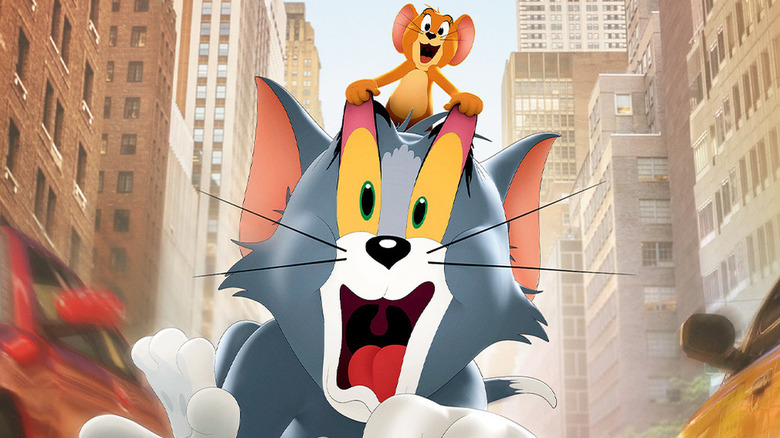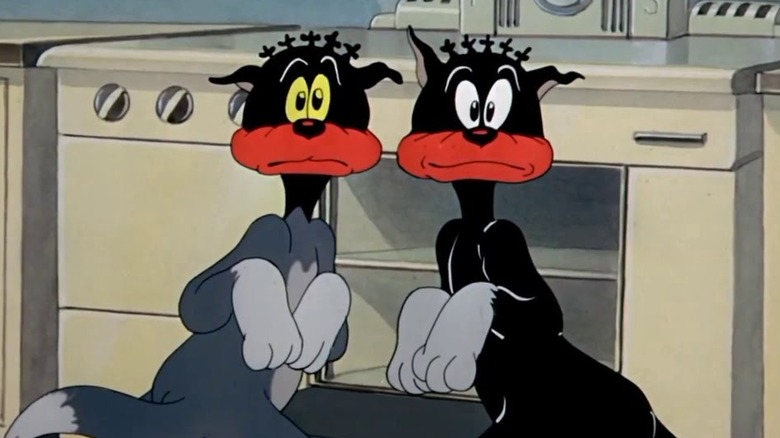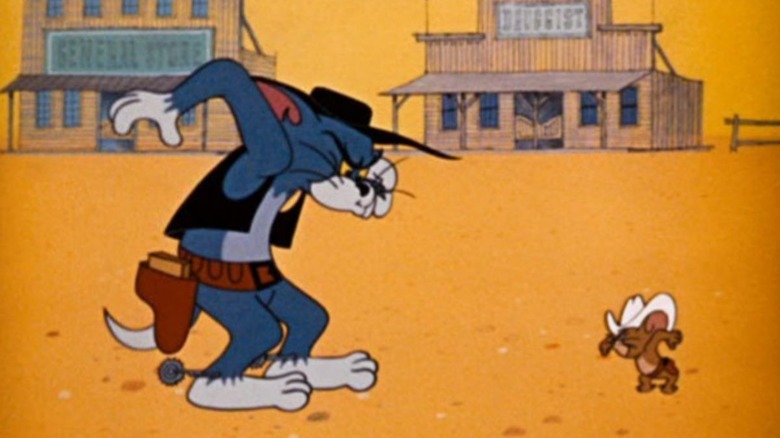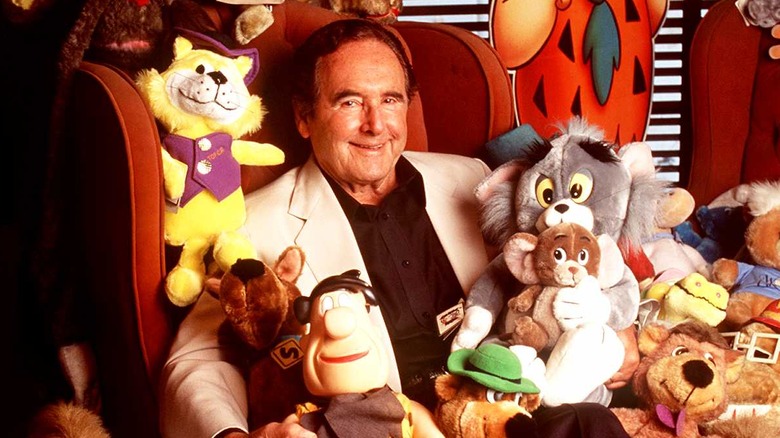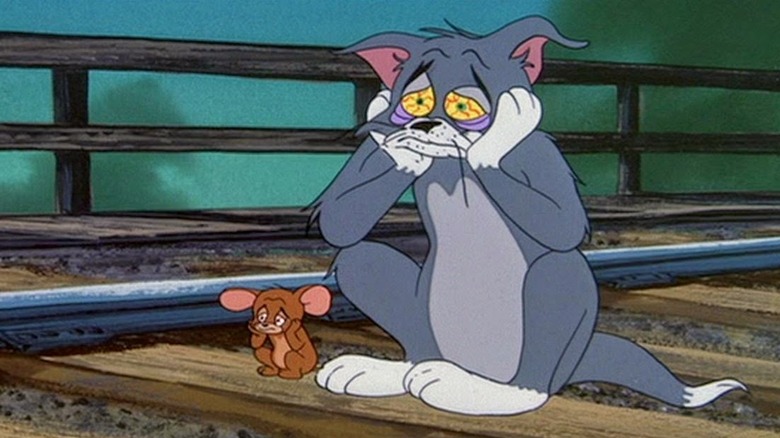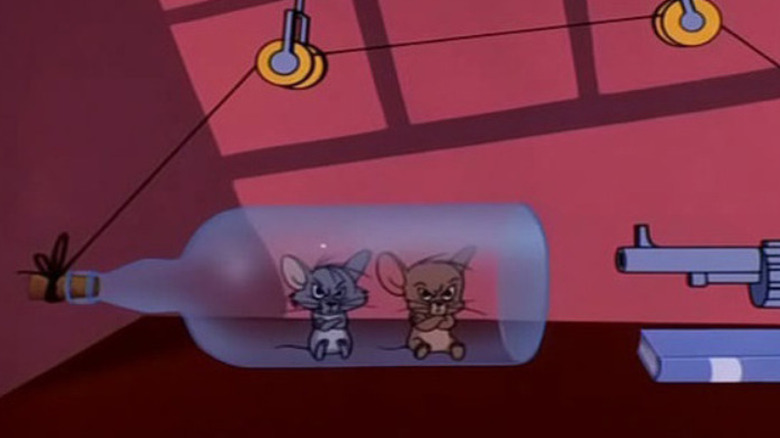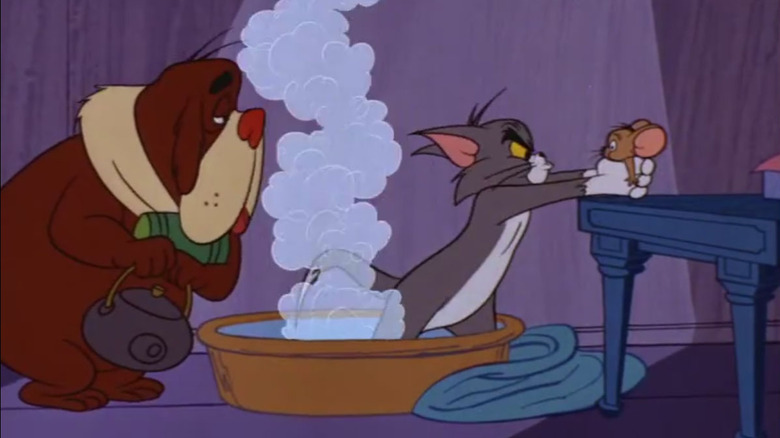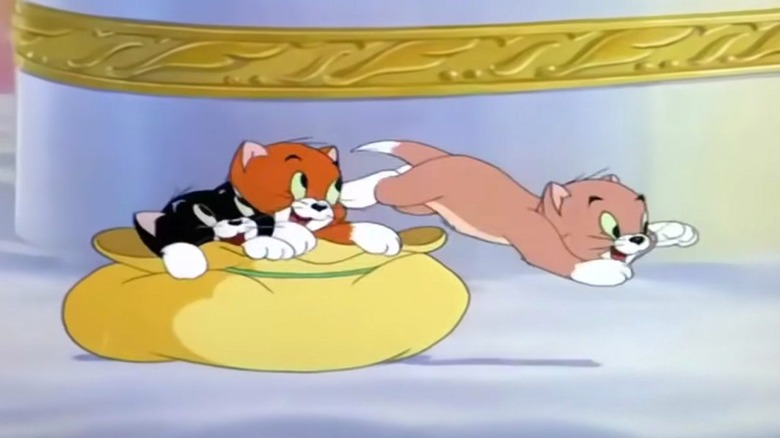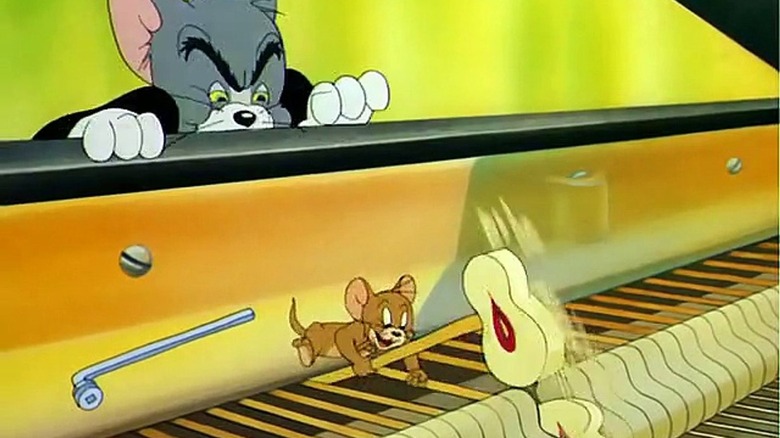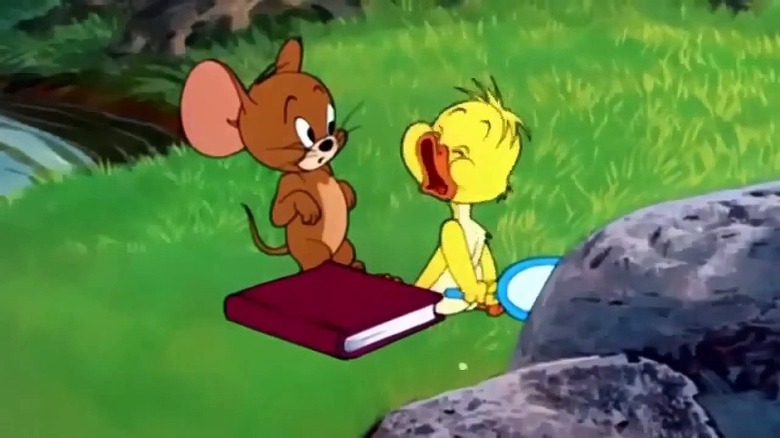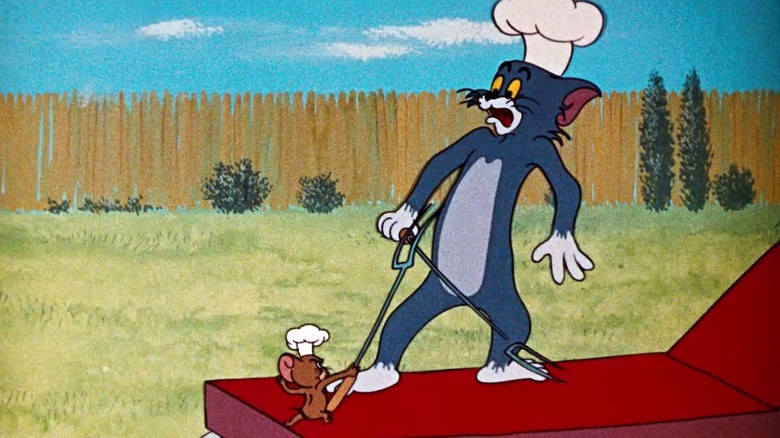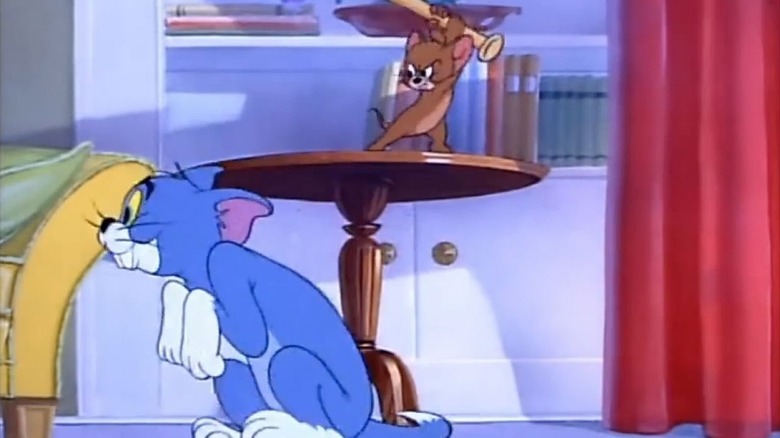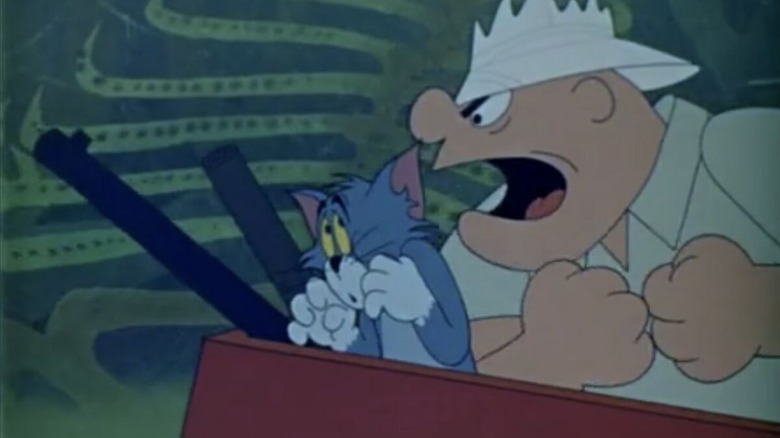The Dark History Of Tom And Jerry
Old-school Hollywood has given us many memorable comedy duos over the years — Laurel and Hardy, Abbott and Costello, and Cheech and Chong, to name just a few examples. One of the oldest and most famous comedy duos of the animation industry are that wily twosome Tom and Jerry, whose literal game of cat and mouse has entertained many generations of fans.
The premise of the "Tom and Jerry" cartoons is exceedingly simple. Tom is a housecat who is charged with protecting his house from unwanted intruders. Jerry is a mouse, and one such intruder who is living rent free in Tom's house and his mind. Thus the stage is set for a battle of tiny but still epic proportions as Tom and Jerry try to outwit each other at every turn in their eternal quest to dominate the other.
Over the years this simple premise has given audiences some of the most beloved cartoon episodes of all time, and turned Tom and Jerry into international icons for children and adults. But the stratospheric success enjoyed by the animated duo did not come easily or without certain hiccups along the way. Here are some darker facts about the legacy of "Tom and Jerry" that fans might not be aware of.
A racist past
"Tom and Jerry" got its start in the 1940s, and especially in the beginning, it was very much a product of its time. One particularly troubling example of this is the frequent racist caricatures of Black people that the series made use of, most evident in the character of Mammy Two Shoes, the maid of the house where Tom and Jerry live.
Whenever Mammy speaks, she sports a very stereotypical "Black" accent as well as showing numerous negative traits that Black women in pop culture have long been stereotypically saddled with. The character of Mammy has been a frequent source of criticism for "Tom and Jerry," to the extent that certain episodes were re-edited to replace her with a character who would be considered less offensive to any particular community.
Apart from Mammy, there are other instances of blackface gags appearing in early episodes of "Tom and Jerry," and today such episodes are either removed completely from their seasons or accompanied by a warning from the studio regarding the potentially triggering nature of the storyline. In modern "Tom and Jerry" cartoons, Mammy Two Shoes has been replaced by another female character, named "Mrs. Two Shoes."
Made in secret
Animation has never been a cheap process, and studios have tried various methods over the years to cut corners and bring costs down while making cartoons. Sometimes cutting corners meant making deals with ideological enemies, as happened during the height of the Cold War when MGM turned to the communist nation of Czechoslovakia for help making their shows at much cheaper costs than stateside animation would require.
In the 1960s, many of MGM's most popular cartoons like "Tom and Jerry" and "Popeye" were made in animation studios located in Prague. American directors and writers would come up with episode storylines and what the characters would be doing in the episode, then send their notes to the studios overseas, where an army of Czech animators would create the entire episode reel, and also the background music and special effects.
Naturally the American public would have been aghast to find out that their favorite cartoons were made through a collusion with perceived "enemies," so MGM took pains to hide the fact that their cartoons weren't being made in America. One way they did so was by "Americanizing" the names of the animators in the end credits of each episode to present the idea that the cartoon had been made by an all-American team.
Hogging the credit
The idea for "Tom and Jerry" was initially conceived by animators William Hanna and Joseph Barbera as a series of comedy short films. The duo needed to get a studio on board with the idea so they could get the resources to make and distribute their shorts; MGM was one of the biggest names in town with regards to animation, and Hanna and Barbera managed to get their foot in the door at the studio with the option to pitch their own ideas to the company.
At MGM, Hanna and Barbera came into contact with producer Fred Quimby, who gave them the green light to create the cartoons under the studio's ownership. In his capacity as a producer, Quimby made sure to attach his name to the wildly popular "Tom and Jerry" shorts — and he also took to the stage to accept the seven Academy Awards that "Tom and Jerry" won in its initial years.
This rubbed Hanna and Barbera the wrong way, since they were not even invited to the stage to receive the awards despite being the guys who made it all happen on the artistic side of things. "It was the most outrageous thing in the world," Joseph Barbera stated in an interview. "[Quimby] was a businessman. [He was] taking credit for the cartoon, and taking the Oscar. How could this happen?" Barbera also expressed his disbelief over the fact that he and Hanna won seven Oscars in their lifetime, and someone else stepped up on stage to claim them all.
The most depressing episode
"Tom and Jerry" was a show aimed squarely at kids, but the situations the series mined for comedy were quite often distinctly adult. While this allowed the show to appeal to a very wide age demographic, it also sometimes led to storylines that are shockingly dark and unfit for kids. Possibly the most famous example is the seven-minute short "Blue Cat Blues."
The episode tells the story of how Tom becomes completely smitten with a female cat. Desperate to win her love, he goes from one extreme to the other, from spending all his cash on expensive presents to taking out multiple mortgages after running out of money. All of Tom's efforts are in vain because of a rich rival cat who outdoes him at every turn.
Thoroughly disillusioned, Tom decides to end it all by waiting on a train track for an approaching locomotive. Even worse, Jerry joins Tom on the tracks after also being romantically spurned. The episode ends with Tom and Jerry looking absolutely miserable and waiting for their demise, which might just be the most depressing end to a cartoon ever.
The trap from Saw
In its early years, "Tom and Jerry" was a show whose main draw was its slapstick violence. Sure, later on the cat and the mouse became friends who went on many adventures together, but their early relationship was earmarked by a willingness to hurt each other and various supporting characters in the most gruesome manner.
The writers had to come up with imaginative ways to depict all this violence onscreen, and sometimes they were a bit too good at their job. Case in point: In the episode "The Year of the Mouse," Jerry and his mouse friend are teasing Tom for fun. After managing to nab them, Tom places Jerry and his pal in a glass bottle that is rigged in such a way that a pistol will fire directly at the two mice if they try to escape.
Tom's elaborate and deadly trap might remind modern horror movie fans of a very similar trap design that shows up in "Saw II." It says much about the diabolical genius of Tom (and the cartoon's writers) that a cartoon trap could fit right into one of the goriest horror franchises ever created.
The Tom and Jerry disease
There are few cartoon series as well-known around the world as "Tom and Jerry." That enduring level of popularity has led to lots and lots of merchandise with the cartoon duo's faces plastered all over it. But the "Tom and Jerry" brand has also been attached to something far more grim — namely, the disease known as "Tom and Jerry syndrome."
Real-world cats are extra sensitive to ultrasonic frequencies which help them hunt their prey in the wild. But sometimes older cats have greater-than-normal sensitivity to such sounds, and can even suffer seizures as a result. Such a condition has been nicknamed the "Tom and Jerry syndrome," since Tom in the cartoons often gets scared by loud noises.
While naming a disease after a cartoon can help raise awareness, there is nothing comedic about the suffering of cats who have to deal with the syndrome. Fortunately, research is currently underway to find ways to help alleviate the condition.
The three kittens in heaven
The episode "Heavenly Puss" follows Tom's journey into heaven after he meets his end following a freak accident. It's a pretty wild episode on its own, featuring a cartoon version of hell complete with a red maniacal bulldog who is apparently Satan, who wants nothing more than to make a shish kebab out of Tom with his pitchfork.
But as disturbing as the other elements of the show are, nothing tops a throwaway bit that occurs early on. While Tom is waiting in line to get into heaven, three little kittens roll into the queue together, their adorable faces popping up out of a burlap sack. The implication is clear — that the kittens were drowned in the sack at a depressingly young age.
What makes the scene even more gut-wrenching is how playful the kittens appear to be, completely unaware of the horrifying incident that caused them to come to heaven. Interestingly, the kittens have a much bigger role in a later episode titled "Triplet Trouble," where they are adopted into Tom's house and show a devilish side to their personalities by turning the entire house upside down. After that, the kittens continued to pop up in various episodes.
Accusations of plagiarism
The American animation industry saw an explosion of content in the '90s, but before that, there were historically only a few major players in the field, each with their own marquee characters. Just as MGM had "Tom and Jerry," Warner Bros. had Bugs Bunny and the rest of his pals from the "Looney Tunes" franchise that were also immensely popular at the time.
Naturally the two studios engaged in a lot of rivalry over their characters. Matters came to a boiling point with the Oscar-winning episode "The Cat Concerto." In the episode, Tom plays the role of an expert pianist trying to give the performance of a lifetime. But Jerry, who is living in the piano, is aggravated by all the noise and tries everything he can to derail the performance. The episode was an instant hit with critics and general audiences, and it's considered one of the best "Tom and Jerry" episodes ever made.
Unfortunately, it bears more than a passing resemblance to a "Looney Tunes" episode titled "Rhapsody Rabbit" released the same year where Bugs Bunny is a pianist trying to deal with a pesky mouse in his piano. Both MGM and Warners accused the other of plagiarism, and the matter was never truly resolved.
Using tragedy for comedy
The episode "Blue Cat Blues" is already infamous in the "Tom and Jerry" canon for showing its lead characters preparing to take their own lives. But an even more extreme version of this plot occurs in the episode "Downhearted Duckling," which focuses on Quacker, a little baby duckling that Jerry befriends and tries to help out.
After reading "The Ugly Duckling," Quacker has a crisis of confidence. Convinced that he is extremely ugly and unlovable, he tries many times to take his own life by offering himself as food to Tom. The story becomes about Jerry having to repeatedly prevent Quacker from allowing himself to be eaten; fortunately, the episode ends with Quacker having his confidence restored and no longer being suicidal.
Even by the standards of old-school cartoons with disturbing themes and storylines, there's something heartbreaking about a child cartoon character wanting to end it all because of low self-esteem. Fortunately future appearances of Quacker the duckling were a lot more cheerful, and he remains one of the most popular characters in the "Tom and Jerry" canon.
Hated by the showrunner
In 1957, MGM's cartoon division closed production on many of their projects, but the popularity of "Tom and Jerry" demanded that the show must somehow go on. That's when Gene Deitch was hired by MGM to create a fresh batch of shorts about the cat and mouse duo. Even though "Tom and Jerry" was more popular than ever, Deitch's work received a greatly mixed reaction from fans and critics.
Because Deitch's shorts were made outside of America using fewer resources, the cartoons often have a choppy, poorly-animated feel to them. Additionally, Deitch made many changes to the themes and settings of the "Tom and Jerry" world that hardcore fans disagree with. For his part, while Deitch acknowledges the complaints many have with his work on the show, he has also been open about his own dislike for "Tom and Jerry" in general, and admits he only started working for the franchise for the money.
"In spite of my negative feelings about the T&J cartoons, as being senselessly violent, and downright racist, I knew this was a crossroad," Deitch wrote for Cartoon Research. "Our career and personal lives were on the line; so I put everything I had into [working on Tom and Jerry]." Gradually Deitch warmed up to the premise of "Tom and Jerry," and likened the never-ending battle between the two characters to an epic biblical clash between David and Goliath where "the little guy can win (or at least survive) to fight another day."
Controversy over unsuitable content
While "Tom and Jerry" is generally regarded as a child-friendly cartoon today, the series was deemed anything but in its early years. Remember that the show is based around the two central characters doing everything possible to slice, puncture, maim, injure, and generally destroy each other with every available resource.
That's the premise of a horror movie, not a children's show, and parents have not always been on board with such storytelling in a series that's aimed at a very young audience. For instance, there was the time Britain decided to censor scenes from "Tom and Jerry" that depicted the characters smoking. The studio has also been famously wary of releasing episodes of the show where characters are seen wearing blackface.
Then there was the time Egypt's State Information Service head Salah Abdel Sadek blamed "Tom and Jerry" for a rise in violence in the country, stating (via The Washington Post) that the show depicts "the violence in a funny manner and sends the message that, yes, I can hit him ... and I can blow him up with explosives." The result of similar outcries from other sources is that modern versions of "Tom and Jerry" have toned down the violence considerably, and in the process lost a significant aspect of the knockabout slapstick comedy that made the cat and mouse team such a hit in the first place.
The most hated character
"Tom and Jerry" is a show that centers around violence in one form or another. Tom has tried to hurt or kill Jerry many times, Jerry has returned the favor in full measure, and characters like Spike the bulldog also wreak havoc on the proceedings at various points. But despite their frequently violent behavior, the series manages to make almost all of its characters lovable.
All except one — possibly the most hated character from the "Tom and Jerry" franchise. During the Gene Deitch era of the cartoons, a new owner was introduced for Tom, a round, balding man with a permanent scowl on his face who shares certain similarities with another one of Deitch's creations, Clint Clobber. Unlike Tom's other owners, this one was often viciously abusive towards his cat, and was depicted as an out-and-out villain.
Whenever Tom's owner got angry, his face turned red and he bared his teeth. He then invariably inflicted some kind of punishment on Tom, from screaming at him to beating him or slamming objects on his fingers. To make things worse, it was implied that the owner got some sort of sadistic pleasure out of such actions, and could be seen grinning afterward. Fortunately for the poor abused feline, this owner only appeared in three shorts before being quietly retired from the franchise.
